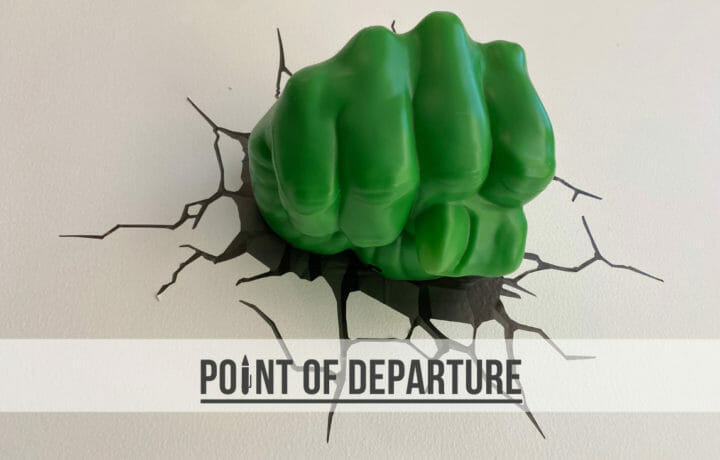“That’s my secret, Cap. I’m always angry.” – Bruce Banner, The Avengers
Anger. Among any list of human emotions, anger always stands out from the rest. It grips us. It consumes us. It spurs us to violent reaction. And, no matter how hard we try, it affects us all.
Anger leaves an indelible memory. The teacher who grew annoyed with you. The parent who lost patience with you. The manager who vented their frustrations on you. You never forget the authority figures in your life whose anger erupted at you, on you, or around you. Those memories tend to leave a mark.
Anger has been a part of who I am for as long as I can remember. Along with all of the good traits I inherited from my father, I also gained his bad temper. As a boy, I channeled it into contact sports, but there were more than a few times where it exploded off the field, and I was left dealing with the consequences. Over the years, I learned other ways to temper my temper, but it was always there, seething just below the surface.
Anger. What are you going to do?
Taming the Wild Beast
Fundamentally, emotions are an inherent part of the workplace. Mix a few diverse personalities in a work environment, and emotions will inevitably become a factor. Positive emotions are generally easy to manage and tend to have an equally positive impact on a workforce. Negative emotions, especially anger, present a much more significant challenge to leaders.
Like any other emotion, anger presents itself in stages across a spectrum. Understanding your anger is a necessary first step toward managing – and controlling – it. Recognizing the stages of anger ensures that you have the opportunity to act in advance of the aftermath and to avoid the unpleasant consequences that often follow an outburst.
- We all get annoyed at work. Someone drops a last-minute task in your email inbox as you’re getting ready to walk out the door on Friday. Your boss makes a decision without considering all of the consequences involved. A subordinate’s actions put you in a vulnerable position. Understandably, you get annoyed. When you find annoyance wedging its way into your psyche, recognize it and deal with the source immediately. Whatever you do, don’t let your annoyance fester like an open wound.
- But you did let it fester, and now your stress levels are up, and your frustration is starting to show through. You feel resentful, and naturally sense a desire to express it. Don’t. Take a few slow, deep breaths. Relax your muscles, ease your stress. Once you’ve begun to reign in the emotional response, decide where the situation is one that you can accept, change, or release. Make a decision based on fact, not emotion, and move forward.
- Instead, you tried to suppress your frustration or just simply let it escalate. Now you’re openly hostile. You want to act. You need to act. Your limbic system – the fight or flight response – kicks into high gear. The parts of your brain responsible for rational thought and moderating social behavior aren’t working as designed. You have one choice: get up and walk away. Walk off the energy and give time to allow calmer thoughts to prevail. Then revisit the situation once you’ve calmed down.
- But you didn’t, and now the big guy wants to come out. If you’ve come this far, the options are limited. Using the 4-7-8 breathing technique is a proven method for taming the wild beast. But if you’ve come this far, your ability for rational thought is probably more than a little clouded. So, I recommend keeping this handy reference card laminated and close at hand. Think of it as a reserve parachute for your temper; when your main fails, you need a reserve.
Leading Through Anger
How you manage your anger as a leader is often a broader reflection of your own emotional and social intelligence. Anger is simply an emotion, like so many others. While you should never allow your emotions to make decisions for you, they will always be present in some form. Don’t suppress them, because doing so is counterproductive. Successful leaders learn how to channel their emotions – even anger – productively.
In their 2015 book, The 15 Commitments of Conscious Leadership, authors Diana Chapman, Jim Dethmer, and Kaley Klemp describe three techniques for managing anger as a leader. First, feel your anger, don’t repress it. Suppressing emotion is unhealthy. Repressing anger, by far the most volatile of human emotions, will only make matters worse. Think Mentos and Diet Coke, but inside your body. It won’t be pretty. Second, express your anger, don’t hide it. That doesn’t mean you should spew toxic aggression whenever you feel like it – the opposite, in fact. Express your anger, but in a calm, rational manner. It’s an emotion. People shouldn’t feel obligated to run from it. Third, learn from your anger, don’t waste it. Park the drama. Leave the histrionics for someone else. Help others learn from the anger; use it as a teaching opportunity. Then solve the problem and move on.
Ultimately, anger is simply another human emotion. You choose whether the expression of that emotion is healthy or not. If, like me, you’re a leader with a temper, it helps to have some practical tools in your emotional kit bag to better manage and channel your anger. Nobody likes you when you’re angry, after all.



